| dc.contributor.author | Morinay, Jennifer | |
| dc.contributor.author | De Pascalis, Federico | |
| dc.contributor.author | Catoni, Carlo | |
| dc.contributor.author | Benvenuti, Andrea | |
| dc.contributor.author | Imperio, Simona | |
| dc.contributor.author | Rubolini, Diego | |
| dc.contributor.author | Cecere, Jacopo G. | |
| dc.date.accessioned | 2023-02-13T10:06:50Z | |
| dc.date.available | 2023-02-13T10:06:50Z | |
| dc.date.created | 2022-09-21T12:39:21Z | |
| dc.date.issued | 2022 | |
| dc.identifier.citation | Frontiers in Marine Science. 2022, 9 . | en_US |
| dc.identifier.issn | 2296-7745 | |
| dc.identifier.uri | https://hdl.handle.net/11250/3050305 | |
| dc.description.abstract | Sensitivity of marine ecosystems to human disturbance leads to an increasing need to devise effective conservation initiatives. One key conservation leverage tool is the establishment of marine protected areas, which can be derived by inspecting where marine sentinel species forage in their most sensitive life cycle phase (reproduction). Depending on their biological and legislative framework, important conservation areas (hereafter, ICAs) can correspond to Important Bird and biodiversity Areas, Key Biodiversity Areas, Marine Protected Areas, etc. Statistical methods allow for standardized assessment of ICAs based on GPS tracking data. However, several biological processes should be accounted for to provide reliable ICAs. In colonial seabirds and sea mammals, individuals breeding in different parts of a colony often spatially segregate while foraging at sea. Besides, environmental conditions may affect the location of foraging areas across years. To what extent relying on data collected in only one part of a colony or in a single breeding season may affect the location and size of ICAs remains unexplored. Here we aimed at 1) highlighting intra-colony and inter-annual heterogeneity of exploited marine areas during reproduction in a colonial seabird, the Scopoli’s shearwaters Calonectris diomedea; and 2) providing guidelines on how to methodologically best account for such spatio-temporal heterogeneity when deriving ICAs. We relied on 397 foraging trips performed by 73 individuals breeding in two distinct areas within the same colony (hereafter, sub-colonies) over 3 years. We showed that areas exploited by shearwaters breeding in two nearby sub-colonies were clearly segregated and differed between years. Relying on only one sub-colony or a single breeding season led to drastically smaller ICAs, biased either east- or west-ward depending on the sub-colony considered. We proposed to account for such heterogeneity by merging the different ICAs obtained for each sub-colony and year, instead of pooling tracking data and deriving a single ICA. Our method led to much larger ICAs, which were less affected by differences in sample sizes across sub-colonies or years, than when ignoring the spatio-temporal heterogeneity. Recently developed standardized statistical procedures and a careful consideration of population spatial structure and temporal heterogeneity will foster robust conservation actions for colonial marine species. | en_US |
| dc.language.iso | eng | en_US |
| dc.publisher | Frontiers Media | en_US |
| dc.rights | Navngivelse 4.0 Internasjonal | * |
| dc.rights.uri | http://creativecommons.org/licenses/by/4.0/deed.no | * |
| dc.title | Assessing Important Conservation Areas for Colonial Species From Individual Tracking Data: An Evaluation of the Effects of Colony Structure and Temporal Heterogeneity in Movement Patterns | en_US |
| dc.title.alternative | Assessing Important Conservation Areas for Colonial Species From Individual Tracking Data: An Evaluation of the Effects of Colony Structure and Temporal Heterogeneity in Movement Patterns | en_US |
| dc.type | Peer reviewed | en_US |
| dc.type | Journal article | en_US |
| dc.description.version | publishedVersion | en_US |
| dc.source.pagenumber | 0 | en_US |
| dc.source.volume | 9 | en_US |
| dc.source.journal | Frontiers in Marine Science | en_US |
| dc.identifier.doi | 10.3389/fmars.2022.854826 | |
| dc.identifier.cristin | 2053898 | |
| cristin.ispublished | true | |
| cristin.fulltext | original | |
| cristin.qualitycode | 1 | |

